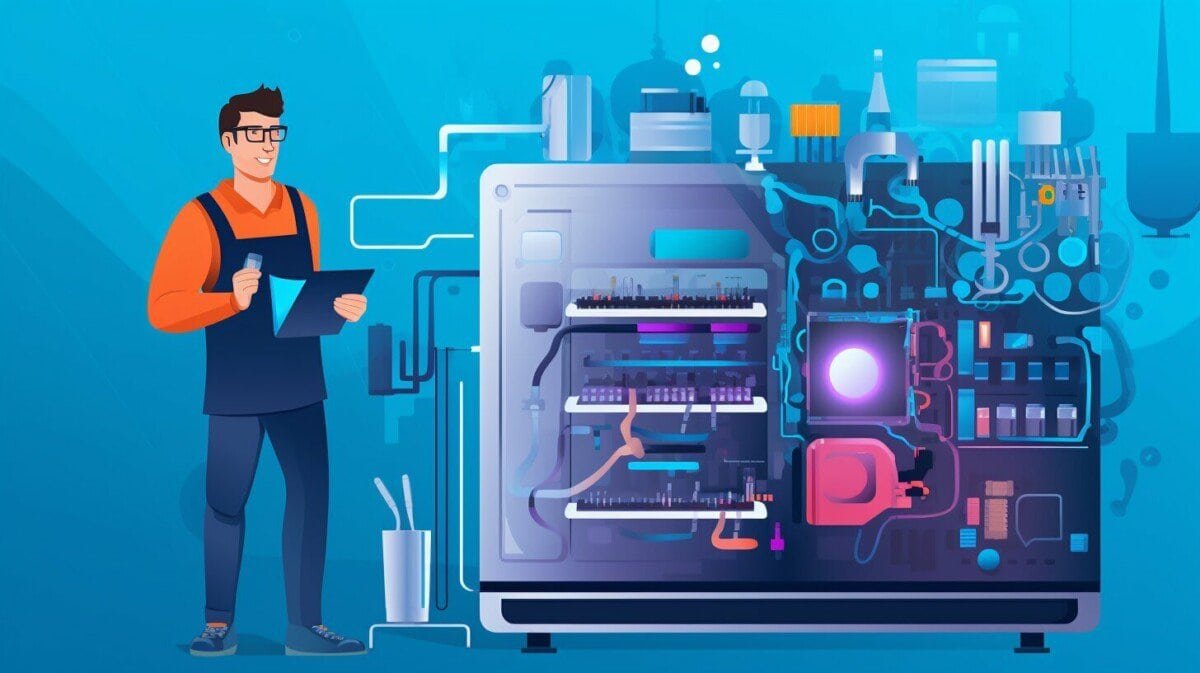If your dishwasher is not working properly, it can be a major inconvenience. However, before you consider calling a technician, it’s important to understand that many common dishwasher problems can be resolved with some basic troubleshooting. In this section, we’ll provide an overview of the most common dishwasher problems and explore some expert tips and solutions to help you fix your dishwasher when it’s not working correctly.
Whether your dishwasher is not draining, won’t start, not cleaning dishes properly, or not drying dishes, we will provide possible causes and solutions to help you troubleshoot and fix the problem. Additionally, we will explore dishwasher error codes and what they mean, as well as tips for maintaining your dishwasher to prevent future issues.
By following this dishwasher troubleshooting guide, you can save yourself time and money in repairing your dishwasher. Let’s get started!
Common Dishwasher Problems
Dishwashers can be a lifesaver in the kitchen, but they’re not immune to problems. Here are some of the most common issues that homeowners face:
| Problem | Possible Cause | Solution |
|---|---|---|
| Dishwasher not draining | Clogged filter or drain hose, faulty pump, or a problem with the garbage disposal | Clean the filter and drain hose, check the pump and garbage disposal |
| Dishwasher won’t start | Power supply issue, faulty door latch/switch, or a problem with the control board | Check the power supply, door latch/switch, and control board |
| Dishwasher not cleaning dishes | Clogged spray arm, faulty spray arm, or a problem with the detergent or water temperature | Clean the spray arm, replace it if necessary, and check the detergent and water temperature |
| Dishwasher not drying dishes | Faulty heating element or a problem with the rinse aid dispenser | Check the heating element and rinse aid dispenser |
If you’re experiencing any of these problems, don’t worry. There are solutions to help you fix your dishwasher and get it back to working properly.
Dishwasher Error Codes
If your dishwasher is displaying an error code, don’t panic. Most error codes can be easily resolved with a few simple fixes. Here are some of the most common error codes and what they mean:
| Error Code | Description | Solution |
|---|---|---|
| ER-1 | The dishwasher’s water level sensor has failed or the dishwasher isn’t filling properly. | Check to ensure that the water supply valve is turned on and the dishwasher is getting enough water. If the valve is open and the dishwasher still isn’t filling, the water level sensor may be faulty and may need to be replaced. |
| ER-2 | There is a problem with the dishwasher’s drain pump or it has failed. | Check to make sure the drain hose and disposal connection are clear of debris. If the dishes are still dirty after cleaning, the drain pump may be faulty and need to be replaced. |
| ER-3 | The dishwasher’s temperature sensor has failed or the water isn’t heating properly. | Check to ensure that the hot water supply valve is turned on and the dishwasher is getting enough hot water. If the valve is open and the dishwasher still isn’t heating, the temperature sensor may be faulty and may need to be replaced. |
If you are unable to resolve the error code yourself, contact a professional dishwasher technician for assistance. Attempting to fix the issue yourself could result in further damage to the appliance.
Dishwasher Not Draining
If your dishwasher is not draining properly, it can be a frustrating experience. Here are some common reasons why your dishwasher may not be draining and some solutions to help you fix the problem.
1. Clogs in the Drain Hose
The most common reason for a dishwasher not draining is a clogged drain hose. To check for a clog, remove the drain hose from the dishwasher and clean it thoroughly with water. You can also use a straightened coat hanger to remove any debris or dirt from the hose. Once you have cleaned the hose, re-install it and test your dishwasher again.
2. Blockages in the Drain Basket
The drain basket is located at the bottom of your dishwasher and filters out food particles and debris. Over time, the drain basket can become clogged and cause your dishwasher not to drain properly. To clean the drain basket, remove it from the dishwasher and clean it thoroughly with warm water and soap. Re-install the basket and test your dishwasher again.
3. Malfunctioning Drain Pump
If the drain hose and drain basket are not clogged, then the issue may be with the drain pump. A malfunctioning drain pump can cause your dishwasher not to drain properly. To check for a malfunctioning drain pump, turn off the power to the dishwasher and remove the drain pump. Check the impeller and motor for any signs of damage. If you spot any damage, replace the pump.
| Problem | Cause | Solution |
|---|---|---|
| Dishwasher not draining | Clogs in the drain hose | Clean the drain hose |
| Dishwasher not draining | Blockages in the drain basket | Clean the drain basket |
| Dishwasher not draining | Malfunctioning drain pump | Replace the drain pump |
With these troubleshooting tips, you should be able to fix the dishwasher not draining problem. However, if the problem persists, it’s best to call in a professional to avoid causing further damage to your dishwasher.
Dishwasher Won’t Start
If your dishwasher won’t start, there are a few possible reasons why. The first step in troubleshooting is to make sure that the dishwasher is properly connected to a power source and that the power is turned on. If everything is connected, but the dishwasher still won’t start, here are some possible causes:
| Possible Cause | Solution |
|---|---|
| The door is not fully closed or the latch is not engaging | Ensure that the door is fully closed and latched properly. If the latch is not engaging, it may need to be replaced. |
| The dishwasher is overloaded | Remove some items from the dishwasher and try again. Overloading can cause the dishwasher to not start. |
| The control panel or touchpad may be faulty | Check the control panel and touchpad for any damage or wear. If they are damaged, they may need to be replaced by a professional. |
| The circuit breaker or fuse has tripped | Check the circuit breaker or fuse box and reset the breaker or replace the fuse if necessary. |
If you have tried all the above solutions and your dishwasher still won’t start, it may be time to call a professional for further assistance. An experienced technician can diagnose and fix more complex issues with your dishwasher.
Dishwasher Not Cleaning
If your dishwasher is not cleaning dishes properly, this can be frustrating and time-consuming. Here are some of the most common reasons for this problem:
| Possible Causes | Solution |
|---|---|
| Dishwasher is overloaded | Try removing some dishes to improve water flow |
| Spray arm is clogged | Remove the spray arm and clean the holes with a toothbrush or wire hanger |
| Detergent dispenser is not working properly | Check for any clogs or replace the dispenser if necessary |
| Water temperature is too low | Check the hot water heater and ensure that water is at the recommended temperature |
If these solutions don’t work, there may be a deeper issue with your dishwasher’s pump or motor. It’s best to call a professional to diagnose and fix the problem.
Dishwasher Not Drying
If you find that your dishwasher is not drying dishes properly, there may be several reasons why. Below are some common causes and solutions:
| Cause | Solution |
|---|---|
| Overloading | Make sure that you are not overloading your dishwasher. Overloading can prevent hot air from circulating properly, resulting in dishes that are not fully dried. Try running smaller loads and see if this solves the problem. |
| Heating Element | Check to see if the heating element is working properly. If it’s not, it may need to be replaced. You can test the element with a multimeter to see if it’s faulty. |
| Vent | If the vent is blocked, it can prevent hot, moist air from escaping, resulting in damp dishes. Make sure the vent is not obstructed and is functioning properly. |
| Wash Cycle | Make sure that the wash cycle is completing properly. If dishes are still dirty or greasy after a cycle, they may not dry properly. Try running the dishwasher on a longer cycle or using a different detergent. |
If none of the above solutions work, you may need to call a professional technician to diagnose and fix the problem.
Tips for Maintaining Your Dishwasher
Maintaining your dishwasher is essential to ensure that it runs smoothly and efficiently. Here are some tips that will help you keep your dishwasher in good shape:
1. Clean the Interior Regularly
Wipe the interior of your dishwasher regularly to remove any debris or residue that may have accumulated. Use a clean cloth and a mild detergent to clean the interior and the racks of your dishwasher. Be sure to remove any food particles that may have accumulated in the filter at the bottom of the dishwasher.
2. Run Hot Water Before Starting Your Dishwasher
Before starting your dishwasher, run hot water in your sink for a few seconds. This helps to ensure that the dishwasher receives hot water from the beginning of the cycle. Hot water dissolves detergent and ensures that dishes are properly cleaned.
3. Use the Right Detergent
Make sure to use the right detergent for your dishwasher. Check the manufacturer’s instructions for recommended detergents. Using the wrong detergent can damage your dishwasher and result in poor cleaning results.
4. Run Your Dishwasher Regularly
To keep your dishwasher in good working condition, run it regularly. It is recommended to run your dishwasher at least once a week to prevent any build-up of residue or debris.
5. Inspect and Clean the Spray Arms
The spray arms of your dishwasher are responsible for distributing water to clean your dishes. Over time, they can become clogged with debris or food particles. Inspect the spray arms regularly and clean them with a soft brush or toothbrush to ensure that they are functioning properly.
By following these tips, you can ensure that your dishwasher runs smoothly and effectively for many years to come.
Dishwasher Replacement: When to Consider It
Your dishwasher is an essential appliance in your kitchen, but unfortunately, it won’t last forever. There will come a time when you need to consider a dishwasher replacement. Here are some signs that indicate it’s time for a new unit:
| Signs that indicate a dishwasher replacement |
|---|
| Your dishwasher is more than 10 years old. |
| The cost of repairing your dishwasher is more than half the cost of a new unit. |
| Your dishwasher is not energy efficient, and you are looking to save on your energy bill. |
| Your dishwasher is not cleaning your dishes properly, even after maintenance and troubleshooting. |
| Your dishwasher is making strange and loud noises during operation. |
If you are experiencing any of these issues, it may be time to invest in a new dishwasher. A new unit will not only save you money on repair costs and energy bills but also provide better performance and efficiency in washing your dishes.
Tips for Choosing a New Dishwasher
If you have decided to replace your old dishwasher, here are some tips to help you choose the right one:
- Consider the size and capacity of your new dishwasher to ensure it fits your kitchen space and meets your cleaning needs.
- Choose a dishwasher with an Energy Star rating for energy efficiency and cost savings.
- Look for a dishwasher with a variety of washing cycle options and features to ensure efficient and effective cleaning of dishes and utensils.
- Read reviews and ratings of different dishwasher brands and models to get an idea of their performance and reliability.
By considering these tips, you can make an informed decision about your new dishwasher and ensure it meets your needs and expectations.
FAQ: Frequently Asked Questions
Here are the answers to some of the most frequently asked questions about troubleshooting dishwashers:
Q: What should I do if my dishwasher isn’t cleaning dishes properly?
A: First, check and clean the dishwasher’s spray arm, filters, and detergent dispenser. You may also want to run hot water in the sink before starting the dishwasher to ensure that the water entering the dishwasher is hot enough. If these steps don’t resolve the issue, it may be a problem with the dishwasher’s pump or motor.
Q: My dishwasher won’t start. What can I do?
A: Check to ensure that the dishwasher is properly connected to a power source and that the circuit breaker hasn’t tripped. You may also want to check the dishwasher’s door latch and control panel. If these steps don’t work, the issue may be with the dishwasher’s motor or timer.
Q: What should I do if my dishwasher isn’t draining properly?
A: First, check and clean the dishwasher’s filters, drain hose, and garbage disposal. You may also want to ensure that the drain hose isn’t kinked or clogged. If these steps don’t work, the issue may be with the dishwasher’s pump or motor.
Q: Why is my dishwasher not drying dishes properly?
A: Check and clean the dishwasher’s heating element and rinse aid dispenser. Make sure that the dishwasher is set to the appropriate dry cycle. If these steps don’t work, the issue may be with the dishwasher’s thermostat or control panel.
Q: How often should I clean and maintain my dishwasher?
A: It’s recommended to clean the dishwasher’s spray arm, filters, and interior once a month. You should also check and clean the dishwasher’s gasket and door latch periodically. Regular maintenance can prevent many of the common issues that require troubleshooting.
Q: When should I consider replacing my dishwasher?
A: If your dishwasher is more than 10 years old or if it requires expensive repairs, it may be more cost-effective to replace it. You may also want to consider upgrading to a newer model with more advanced features and energy efficiency.
Q: Is it safe to attempt to repair my dishwasher on my own?
A: While some dishwasher issues can be resolved with basic troubleshooting steps, it’s important to exercise caution when attempting to repair your dishwasher. If you’re not confident in your abilities, it’s better to consult a professional repair service.
Remember, proper maintenance and regular cleaning can prevent many of the common issues that require troubleshooting. If you need additional help, consult your dishwasher’s owner’s manual or contact a professional repair service.




